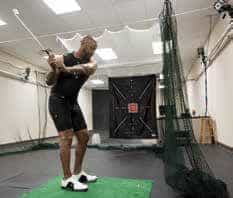Orthopaedics Researchers Explore Biomechanics From All Angles
Research is on the move at the UAMS Department of Orthopaedic Surgery.

How knee replacements affect golf swing is one of several UAMS Department of Orthopaedic Surgery studies at the high-tech gait and motion-detection laboratory at the HipKnee Arkansas Foundation.
Researchers are studying biomechanics using the high-tech gait and motion-detection laboratory at the HipKnee Arkansas Foundation. By researching the structure and function of human movement in a variety of contexts, the goal is to improve the development and assessment of orthopaedic interventions and better understand injury prevention.
Erin Mannen, Ph.D., a mechanical engineer from the University of Kansas, joined the UAMS faculty in mid-2017 to lead biomechanical studies of the spine, bone and joints.
To do so, she uses technology that fills an entire room at HipKnee Arkansas. Special cameras at strategic points along the walls create a 3D capture zone. The research subject wears markers that are tracked by the cameras and recorded by the computer software.
“We are able to see how nearly every part of the body is moving,” Mannen said. “We can measure how people move using the cameras, how they load their joints using force plates embedded in the ground, and how their muscles are activating using electromyography.”
Mannen’s current work focuses on infants. Some of it is specific, like whether babies with hip dysplasia could be treated by being held

Electromyography sensors – to detect muscle activity – is one of several technologies in use at the gait and motion-detection laboratory that allow researchers insight into human movement in a variety of contexts.
by adults in “babywearing” carrier devices. Other studies cast a wide net, filling in the gaps of knowledge about infant motion where existing research is limited.
“We are looking at infant muscle and motion activity in various positions to get a baseline understanding of how infants are using their muscles in common positions. We want to understand optimal positioning to prevent musculoskeletal problems or motor development delays,” Mannen said.
Meanwhile, department Chair C. Lowry Barnes, M.D., is studying how joint replacements affect golf swing in athletes. Simon Mears, M.D., Ph.D., is studying safe yoga practice in hip and knee replacement patients.
“With this technology, we are limited only by our imaginations,” Mannen said. ν